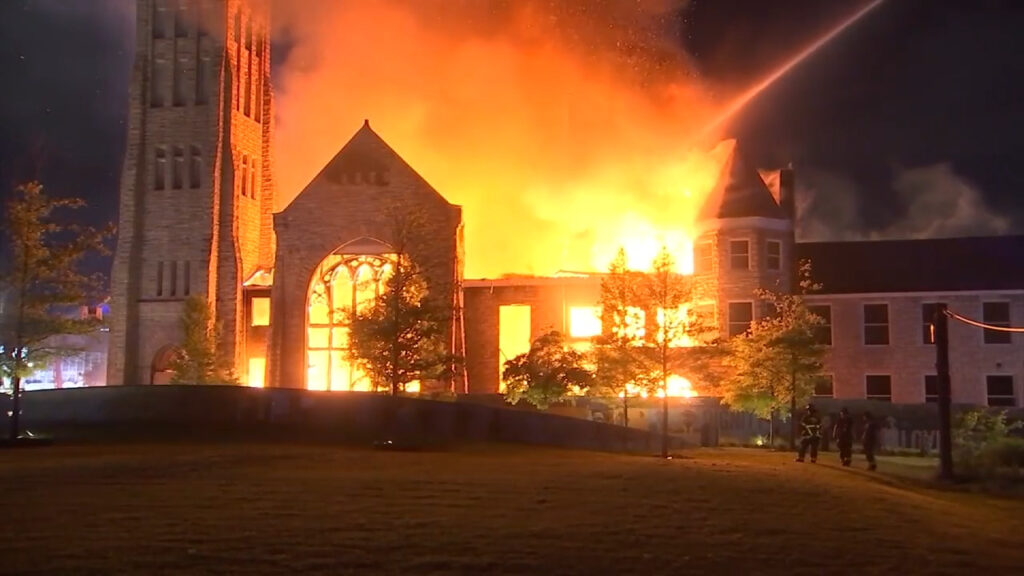MEMPHIS, Tenn. — Clayborn Temple, the historic Black church in downtown Memphis that served as a crucial organizing center for Martin Luther King Jr.’s final civil rights campaign, was heavily damaged by fire early Monday morning, dealing a devastating blow to an icon of American history.

Memphis Fire Chief Gina Sweat confirmed that the blaze left the interior of the Romanesque revival church a “total loss,” though officials remain cautiously optimistic that parts of the façade can be salvaged. Fire crews were alerted to the fire at 1:39 a.m. by a commercial alarm service. The cause of the blaze remains under investigation by local fire and police authorities, as well as the U.S. Bureau of Alcohol, Tobacco, Firearms and Explosives.
“It’s way too early to determine anything,” Sweat said during a news conference Monday morning.
Clayborn Temple holds a revered place in the American civil rights movement. It became the organizing hub in 1968 when King came to Memphis to support the city’s sanitation workers—predominantly Black men protesting dangerous working conditions and low wages. The workers had galvanized after the tragic deaths of Echol Cole, 36, and Robert Walker, 30, who were crushed by a malfunctioning garbage compactor. Lacking basic employment protections such as workers’ compensation and life insurance, the men’s deaths became a rallying cry for the movement.
City officials at the time deemed the sanitation workers’ strike illegal, leading to mass arrests and heightened tensions.
Before Monday’s fire, Clayborn Temple was in the midst of a $25 million restoration effort, aimed at preserving its historic architecture and reviving its role as a community cornerstone. Scheduled for completion in 2026, the project included plans to restore a 3,000-pipe grand organ, launch a museum, and provide cultural programming and neighborhood outreach.
“This morning we woke up to heartbreaking news: a devastating fire has ravaged one of our city’s greatest treasures, Clayborn Temple,” Memphis Mayor Paul Young wrote in a statement posted to social media. “Clayborn is more than a historic building. It is sacred ground. It is the beating heart of the civil rights movement, a symbol of struggle, hope, and triumph that belongs not just to Memphis but to the world.”
Built in 1892 as the Second Presbyterian Church, Clayborn Temple originally served an all-white congregation before it was sold to an African Methodist Episcopal Church congregation in 1949 and renamed Clayborn Temple.

A Center for Protest and Resilience
During the sanitation strike of 1968, Clayborn Temple was the site of nightly strategy meetings and the birthplace of the iconic “I AM A MAN” signs carried by strikers. It served as a staging ground for marches to City Hall, including the pivotal march on March 28, 1968, led by King. That protest descended into violence after clashes between demonstrators and police erupted along Beale Street, resulting in the death of a 16-year-old boy.
Police later fired tear gas into the temple itself as demonstrators fled, breaking the church’s stained-glass windows to escape. Determined to lead a peaceful march to correct the violence, King remained in Memphis—but was tragically assassinated on April 4, 1968, while standing on the balcony of the Lorraine Motel.
Following King’s assassination and the eventual resolution of the sanitation strike, Clayborn Temple’s influence diminished. The building fell into disrepair and sat vacant for years until the revival project, launched in earnest in 2017 with the help of a $400,000 grant from the National Park Service.
In 1979, Clayborn Temple was added to the National Register of Historic Places, cementing its legacy as a key site in the story of civil rights in America.
Hope Amid the Ashes
Anasa Troutman, executive director of Historic Clayborn Temple and leader of the restoration initiative, reaffirmed her commitment to rebuilding the church in a Monday statement.
“To everyone who has loved, supported, and prayed for Historic Clayborn Temple, we are still committed to her restoration,” Troutman wrote, encouraging supporters to contribute financially to the rebuilding effort.
Architect Jimmie Tucker, who has long worked on the restoration project, spent Monday developing plans to stabilize what remains of the structure.
“As a native Memphian, this project is personal,” Tucker said. “It has so much meaning.”
Tucker noted that he consulted with individuals involved in restoring the First United Methodist Church after a major fire in 2006. Their experience, he said, provides a measure of hope that Clayborn Temple can rise again.
Mayor Young echoed that sentiment in his social media statement, pledging that the city will “help ensure this sacred place rises again.”
For now, Memphis mourns the damage to one of its most cherished landmarks, but community leaders and citizens alike vow that the spirit of Clayborn Temple — and all it represents — will endure.



